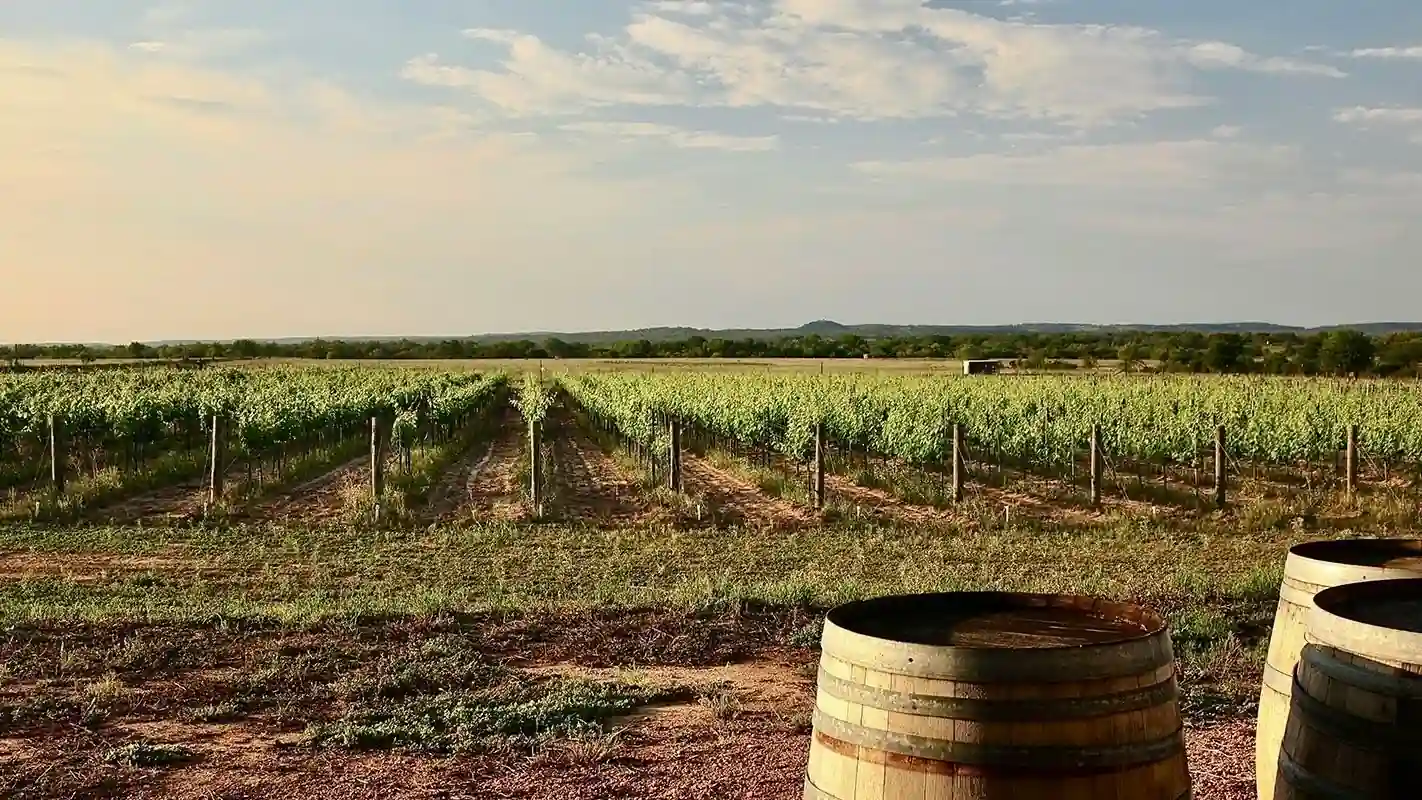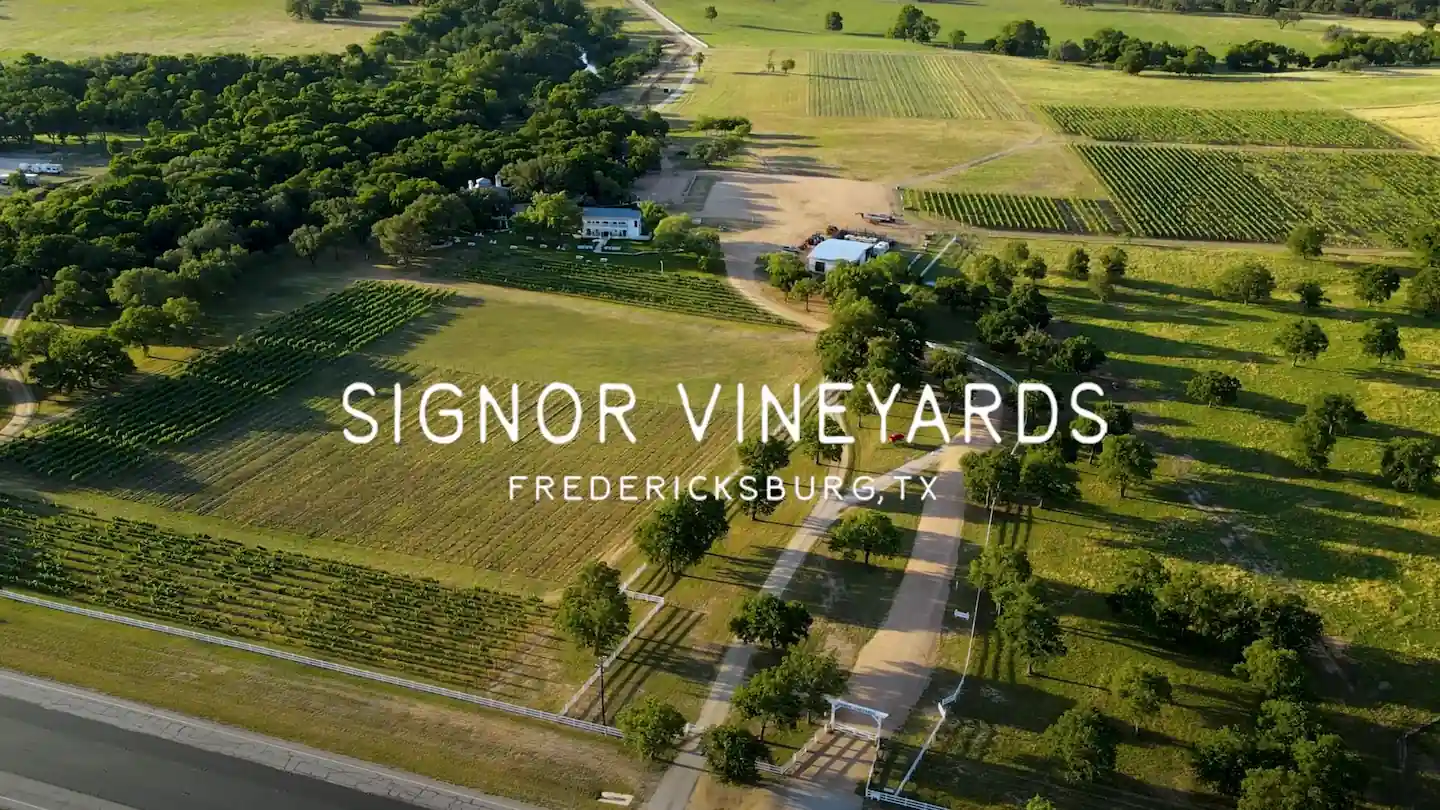Winemaking
Explore Texas Hill Country’s innovative winemaking through insights from local winemakers.
Texas Hill Country spans nine million rugged acres of limestone hills, cedar scrub, and river-cut valleys. Warm summer highs (often 95°F / 35°C) collide with sudden nighttime drops and April hailstorms, forcing growers to make highly strategic choices in the vineyard and cellar.
To see how theory meets practice, we posed questions to three local voices—each working with different sites and scales. Their answers reveal the ingenuity behind modern Texas wine.

How does your local terroir shape the final wine?
Like most wineries in Texas, a majority of Hilmy’s fruit comes from the Texas High Plains, roughly 3,200 feet in elevation, with diurnal shifts that can hit 95°F by day and 60°F at night. Deep silty-loam soils hold water and nutrients, but we still battle early freezes, hail, and high winds.
Down in the Hill Country, it’s more humid and clay-based, so grapes ripen fast and we spend a lot of time on canopy management and fruit thinning. Texas vineyards are a hallmark of agriculture here; results vary by year and by winemaker.
How do you decide which grapes to work with?
The cool thing about Texas grape-growing is that it’s still frontier territory. We choose varieties around our wine plans two or three years out—2025 is a ‘Bordeaux year,’ but 2026 might shift to Rhône, Italian, or Spanish. Grenache, Mourvèdre, and Tempranillo always perform well. Lately we’re loving Tannat: the Hill Country version is plush and inky, the High Plains version is bold and tannic—blending them is taboo for some, but it makes a killer wine.
What’s your philosophy on style and innovation?
Our goal is the best possible wine from the best possible grapes. Wine is art grounded in science. Texas gives us freedom—no rules on oak or aging length—so we honor tradition but aren’t afraid to ferment in a converted cold-storage unit if that’s what it takes.

How do climate and soils across Texas shape your portfolio?
We buy fruit statewide. Blanc du Bois comes from clay north-west of Houston; Aglianico and Sangiovese from sandy-loam Hill Country blocks; Bordeaux reds from the red sandy loam of the 3,000-foot High Plains; and Chardonnay from a high-desert site near the Guadalupe Mountains at almost 4,000 feet. Hill Country fruit can get hailed in April or May, then see drought and heat, but that sandy soil makes wonderfully fruit-driven Sangiovese and Aglianico.
What drives your own vineyard plantings?
Our 43-acre ranch sits on marine clay strewn with limestone. We’ll plant in 2026: first a heat-tolerant Chardonnay clone for méthode traditionnelle sparkling, then Sangiovese for both still and bubbly. We waited because cedar stripping robbed the soil of nitrogen—we’re restoring it with native-grass cover crops before we put a vine in the ground.
How do you balance tradition and innovation?
I’m a fizz nerd, so I bought a neck freezer, a riddling cage, and a disgorging line. I’ve bottled sparkling Trebbiano, Pinot Noir, Grenache, Blanc du Bois, Chardonnay, and Sangiovese. Whites and sparklers stay in stainless, reds in French oak. Lab numbers guide us, but sometimes a blend just pops into my head—that’s the fun part.

What makes your estate’s terroir special?
Our estate sits between the Pedernales River and Grape Creek, so fall and winter mists can drop temperatures five degrees below our neighbors. Generations of cedar and hickory have flavored the soil, and you taste that smoky leather, subtle cedar spice, and earthiness in every glass. Guests pick our wines blind once they recall the ranch’s aromas.
How do you select grapes that cope with Texas extremes?
Viticulture here demands intentionality. Bud break is early, harvest can start in July, and summers bring 10-plus hours of sun. Spanish, Italian, and Rhône grapes love it. Personally, I’m all-in on Cabernet Franc—our new plantings in the high, arid Davis Mountains should give it the elegance it deserves.
How do you explore styles without losing your roots?
Texans know what they like—and they’re not shy about telling you. We listen in the tasting room, watch trends, and keep tweaking blends or trying new varieties. Tradition and terroir ground us, but agility keeps us connected to today’s drinkers.